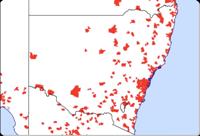2.4 million more Aussies now have 20Mbps

Telstra has announced it has finished switching on ADSL2+ at over 900 exchanges to give 2.4 million Australians a theoretical maximum downlink speed of up to 20 Mbps.

A map showing the availability of ADSL2+ after the exchanges were switched on Credit: Telstra
Earlier this year, Broadband Minister Stephen Conroy gave the telco the regulatory assurances it needed to switch on the ADSL2+ network, according to the company.
However, according to the CEO of the Competitive Carriers Coalition, Dave Forman, the company's decision to switch on the exchanges did not spring from the Minister's assurances but from the desire to rebuild its relationship with the government ahead of the planned rollout of the national fibre-to-the node (FTTN) broadband network.
Since February, 907 exchanges have been switched on, Telstra's group MD of public policy and communications Phil Burgess said, taking some 64 days.
A map showing the availability of ADSL2+ before the exchanges were switched on Credit: Telstra
The popular opinion that "all you had to do was flick a switch" is wrong, said Burgess, adding that although Telstra had the DSLAMs already in place, it had to dig holes, get personnel to them, decommission old lines and connect new lines, requiring a massive transfer of resources.
Burgess hopes the rollout will act as a precursor to a future role in the country's fibre-to-the-node network. "Does it relate to FTTN? Absolutely it does," Burgess said.
Despite speeds of 20Mbps, Australia is still behind, Burgess said: "This is great in Australia, but... the rest of the world is going to 100Mbps."
If Australia doesn't wake up, "we're going to be in bad trouble," he added.
When asked how Telstra wanted to achieve 100Mbps, Burgess said the company was looking at VDSL, saying that under the right conditions it can go up to 100Mbps, and said that FTTN laid the basis for fibre-to-the-home.
"It's all a matter of money," he said.